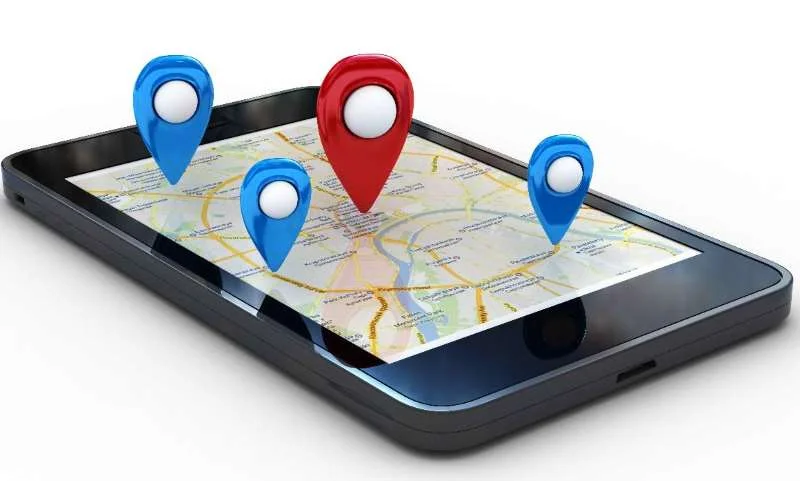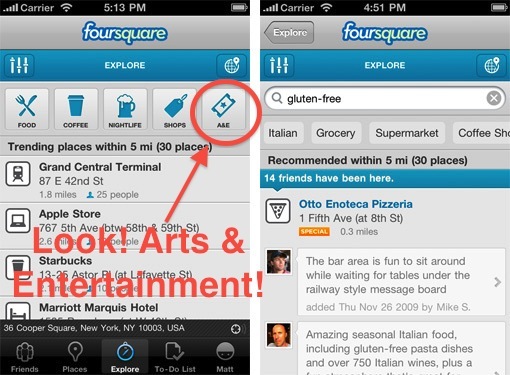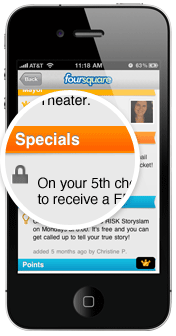Click here for Peixiao Liu's white paper to find out how and why your arts organization should make use of Location Based Social marketing.
7 Technological Behaviors On AMT Lab's Naughty List
Getting Started on Location-based Social Marketing for your Organization
Changing Up The Check-in Pt. 2: Recommendation Engines
 A few weeks ago I wrote a post on some of the latest updates to Foursquare's specials. To make the platform worthwhile beyond just a fun game for users, Foursquare has overhauled a lot of their services with version 3.0. This went beyond just specials, the location-based social network wanted to make using their platform a useful way for users to discover new places in their surroundings.
Boom, new algorithms that form a better recommendation engine for you and me. What does that mean for us non-techies? It means the 'Explore' tab, a new service that takes info from your check-ins, your friends check-ins and presents you with search results of nearby venues that are more relevant to your interests.
A few weeks ago I wrote a post on some of the latest updates to Foursquare's specials. To make the platform worthwhile beyond just a fun game for users, Foursquare has overhauled a lot of their services with version 3.0. This went beyond just specials, the location-based social network wanted to make using their platform a useful way for users to discover new places in their surroundings.
Boom, new algorithms that form a better recommendation engine for you and me. What does that mean for us non-techies? It means the 'Explore' tab, a new service that takes info from your check-ins, your friends check-ins and presents you with search results of nearby venues that are more relevant to your interests.
Hit the explore tab, type in something like 'art' or 'mexican food' and Foursquare will take into account all your and your friends past check-ins to come up with the most relevant venue. So not only will it tell you where a venue is, but why you should want to go there. In addition to searching, there are also buttons along the top focused on common venue types people are looking for. You might already be familiar with how recommendation engines work, it is how music sites like Pandora and Last.fm are able to suggest relevant material for their users.
Image via blog.foursquare.com
So why should arts organizations care? Because this may be the simplest of all ways to participate in the location-based game. Claim your venue, add relevant information and start showing up in search results. Claiming a venue is free, gives you control over your brand, and will improve your search and recommendation results not only with Foursquare, but all of the apps and platforms out there using Foursquare's API (programming language and database) like Gowalla and hundreds of others.
While you're staking your claim with Foursquare, you may want to claim your venue on the two other big location-players - Facebook Places and Google Places. Google has some recommendation engines in the works and while Facebook doesn't offer one, claiming your venue there will still make you more visible to a very large group of users.
Claiming your venue on these three platforms is an easy and free way to take advantage of a fast-growing social media form. It's a simple step that may equal a return for your organization that a lot of other social networks can't offer - foot traffic.
Changing Up The Check-in: Foursquare Updates Specials
Image via foursquare.com
Foursquare, the popular location-based social media platform, decided to shake things up a little at the annual South by Southwest festival last week. Rolling out their new 3.0 version, Foursquare has made some significant changes to their platform in the way it operates, most notably in the way it recommends venues and offers specials.
I'll be covering the changes to the recommendation engine in an upcoming post, but today I really want to talk about the new ways arts organizations can offer specials on Foursquare. A "Special" on the platform refers to an incentive that organizations and brands can attach to a venue that is unlocked when a Foursquare user "Checks In" and meets a certain criteria. Up until last week, these specials were limited to either the frequency a user checked in (1st time, 5th time, etc.) or if the user was the "Mayor", a title held by the user that checks in the most frequently at a particular venue.
While a great idea in concept, personally I felt the result was a little lackluster in practice. Becoming the Mayor of a venue is tough, requiring checking in at that venue a large amount of times to temporarily steal the title. While this may be easy to do for somewhere like a local coffeeshop, frequented everyday, it is unrealistic to offer this incentive for an arts organization. Then there is the average check in, some organizations have offered incentives like reduced ticket prices for having a certain amount of check ins, but this is often a one-time special. The hesitation to use a more tantalizing incentive may be the fact that organizations want a little more involvement than having a user hit a button on their cell phone once.
The game has changed with the release of Foursquare 3.0. More types of specials have been added and split up according to whether they are loyalty specials or customer acquisition specials. Plus, nearby specials now appear when a user hits the "Places" tab in Foursquare's mobile platforms, showing users which nearby venues are offering incentives for their foot traffic. Here's a look at how the new specials work:
Customer Aquisition
![]() The Check-in Special - This is the run-of-the-mill, every-time-you-check-in kind of special. It allows organizations to attach an incentive that users can claim with every check-in and is the one most often seen on the platform. Many organizations may still want to take advantage of this by offering cheaper incentives, such as a dollar off admission, to encourage visitors to adopt Foursquare and take advantage of more rewarding specials in the future.
The Check-in Special - This is the run-of-the-mill, every-time-you-check-in kind of special. It allows organizations to attach an incentive that users can claim with every check-in and is the one most often seen on the platform. Many organizations may still want to take advantage of this by offering cheaper incentives, such as a dollar off admission, to encourage visitors to adopt Foursquare and take advantage of more rewarding specials in the future.
![]() The Newbie Special - Most of the new specials say it right in the name and this is no exception, this rewards users only for their first time check-in. Organizations may want to take advantage of this for the same reason as the regular Check-in special, to encourage initial use of the platform.
The Newbie Special - Most of the new specials say it right in the name and this is no exception, this rewards users only for their first time check-in. Organizations may want to take advantage of this for the same reason as the regular Check-in special, to encourage initial use of the platform.
![]() The Flash Special - Now we start to get into some of the more interesting specials. The Flash special works like a flash sale, once a certain number is reached the special expires. It is first come, first serve. For example, say your special events are dragging a little bit for the first few hours, on average. A Flash Special can be used to create some interest in showing up first, such as "First 10 people to check-in unlock a private meet and greet with ______ !".
The Flash Special - Now we start to get into some of the more interesting specials. The Flash special works like a flash sale, once a certain number is reached the special expires. It is first come, first serve. For example, say your special events are dragging a little bit for the first few hours, on average. A Flash Special can be used to create some interest in showing up first, such as "First 10 people to check-in unlock a private meet and greet with ______ !".
![]() The Swarm Special - Swarm specials are all about building a crowd. Swarm specials are only unlocked if a certain number of users, set by the organization, check-in at that organization's venue within a set three hour period. This can be a great way to reward a large crowd with an incentive that would be more attractive for a group event than for an individual. For example, an organization could have a special encore from a performer if that night's swarm special is unlocked.
The Swarm Special - Swarm specials are all about building a crowd. Swarm specials are only unlocked if a certain number of users, set by the organization, check-in at that organization's venue within a set three hour period. This can be a great way to reward a large crowd with an incentive that would be more attractive for a group event than for an individual. For example, an organization could have a special encore from a performer if that night's swarm special is unlocked.
![]() The Friend Special - This is by far my favorite new special. Users can only unlock this special by having a certain number of their foursquare friends, not just users that happen to be at the venue already, check-in alongside them. When paired with a great reward, this can be a great way to incentivize people to bring their friends along to your venue. The number of friends required to unlock the special is completely up to the organization.
The Friend Special - This is by far my favorite new special. Users can only unlock this special by having a certain number of their foursquare friends, not just users that happen to be at the venue already, check-in alongside them. When paired with a great reward, this can be a great way to incentivize people to bring their friends along to your venue. The number of friends required to unlock the special is completely up to the organization.
Rewarding Loyalty
![]() The Mayor Special - Hey now, we can't forget about the Mayor! This special works the same way as the old special, it is unlocked by the current Mayor of the venue. The Mayor is determined by which user checks in the most times in the previous 60 days and the check-ins only count once per day towards mayorship. This is so a user cannot stand in your lobby and just hit the check-in button over and over again until they have the mayorship.
The Mayor Special - Hey now, we can't forget about the Mayor! This special works the same way as the old special, it is unlocked by the current Mayor of the venue. The Mayor is determined by which user checks in the most times in the previous 60 days and the check-ins only count once per day towards mayorship. This is so a user cannot stand in your lobby and just hit the check-in button over and over again until they have the mayorship.
![]() Loyalty Specials - A little bit like the regular check-in special, this special rewards frequent visitors who are regularly checking in. One version of a Loyalty special gives users a goal of total check-ins to unlock a reward. Since you can set the number, organizations may want to pair this with a sweet reward for that user who visits over 100 times. Again, only one check-in counts towards this special per day. Another parameter organizations can set with Loyalty specials is the time that user has to reach the set goal, such as having a goal of 10 check-ins for one month. This type of special could be paired up with a more temporary event like an exhibition or a performance series.
Loyalty Specials - A little bit like the regular check-in special, this special rewards frequent visitors who are regularly checking in. One version of a Loyalty special gives users a goal of total check-ins to unlock a reward. Since you can set the number, organizations may want to pair this with a sweet reward for that user who visits over 100 times. Again, only one check-in counts towards this special per day. Another parameter organizations can set with Loyalty specials is the time that user has to reach the set goal, such as having a goal of 10 check-ins for one month. This type of special could be paired up with a more temporary event like an exhibition or a performance series.
It will be interesting to see if and how arts organizations take advantage of these new specials that Foursquare has launched. The biggest advantage to the service is that it is one of the few social media platforms out there that require users to physically be in the space. Coming up in a future post, I will go into some of the other improvements Foursquare has made to its platform, including the ways their new recommendation engine will help direct users to your organization.
Top Technology Trends: What’s Ahead for Arts Marketers in 2011
This post also appears as a featured article on artsmarketing.org, hosted by Americans for the Arts.
In this tough economy, most of us have encouraged ourselves and others to look ahead to brighter times. But, what exactly lies ahead in the next year for us? How can we make the most of our future?
In 2010, technology influenced our field tremendously. Some predicted trends, like Google Wave and Google Buzz, failed to take off, and many unexpected trends, like group-manipulated pricing and Ask a Curator, flourished. The following are some major trends that have gathered momentum in the past year and/or are poised to take off in 2011:
Group discounts and group-manipulated pricing Group discount sites exploded in popularity in 2010. While many organizations have a group sales manager or special deals for groups, these sites allow people to opt in to a deal that will only go live if enough people opt in, encouraging people to sell to their friends. Groupon now boasts 35 million subscribers and 18 million Groupons sold in North America. However, marketers question their ability to attract repeat visitors. Now that the initial novelty has worn off, hopefully the knowledge we’ve gained will result in smarter offers. I recently heard from a colleague about a ballet company that didn’t cap their Nutcracker offer and lost revenue on their offer.
Since the advent of these group-buying applications, many variants have cropped up. For example, Uniqlo’s Lucky Counter makes clear to the consumer the advantage of group buying, by lowering the price on the offer in real-time as more people sign up. Arts organizations also started implementing dynamic pricing, similar to the way in which airlines price their tickets.
 iPhone sunset in the Andes by Gonzalo Baeza Hernández via Flickr.
iPhone sunset in the Andes by Gonzalo Baeza Hernández via Flickr.
 iPhone sunset in the Andes by Gonzalo Baeza Hernández via Flickr.
iPhone sunset in the Andes by Gonzalo Baeza Hernández via Flickr.Go mobile or go home: mobile app development and mobile ticketing In 2010 Wired reported “The Web is Dead”, meaning that the way people use the Internet is moving away from web access on a desktop or laptop computer to mobile applications. Arts organizations have started asking themselves if their website is mobile friendly and, along with companies like InstantEncore and Pop Media, have started to develop apps.
Pop Media has developed Cloudtix, which uses Tessitura to sell tickets in real time through mobile apps and download a scanable ticket to their phone.
Bill Predmore of Pop Media compares the rise of mobile apps this year to website development in 1997. “Arts orgs started out with a ‘brochure site’ and slowly began to evolve as they realized their capabilities. Things will happen a lot more quickly this time.”
So if the web is dead, which is worth more investment: mobile websites or mobile apps? And if you are going to develop an app, which platform do you develop it for? While Apple’s iOS devices (including iPad, iPhone, and iPod) still outnumber Android devices, Android phones have overtaken iPhones in terms of market share.
Predmore advises companies to begin to look into all three: iOS, Android and mobile websites. “Things are changing rapidly and it’s difficult to know what’s going to be there a year from now. For this reason, many organizations are reluctant to make an investment. But patrons are going to expect you to be there and if you’re not, there’s a problem.”
Changing media consumption At the same time that Internet usage is shifting to mobile devices, the way audiences consume entertainment is changing. The introduction of tablet-style devices like the iPad and 4G-capable phones running on Android means more people are consuming mobile entertainment, especially video , than ever before. iPad users are also more likely to complete video ads (63%) than desktop video viewers (53%).
In the past several years, performing arts organizations have started taking their performances outside of the theater and concert hall with initiatives like the Met’s Live in HD, San Francisco Opera’s Opera in the Ballpark, and most recently, L.A. Phil Live. In 2010, we saw a shift to more online streaming video. Sites like Tendu TV and classicaltv aggregate video of performances. Streaming on platforms like Livestream has become more commonplace, notably Chris Elam’s efforts with Misnomer Dance Theatre. Recently YouTube announced that it would offer live streaming to its content partners, several of which are arts organizations.
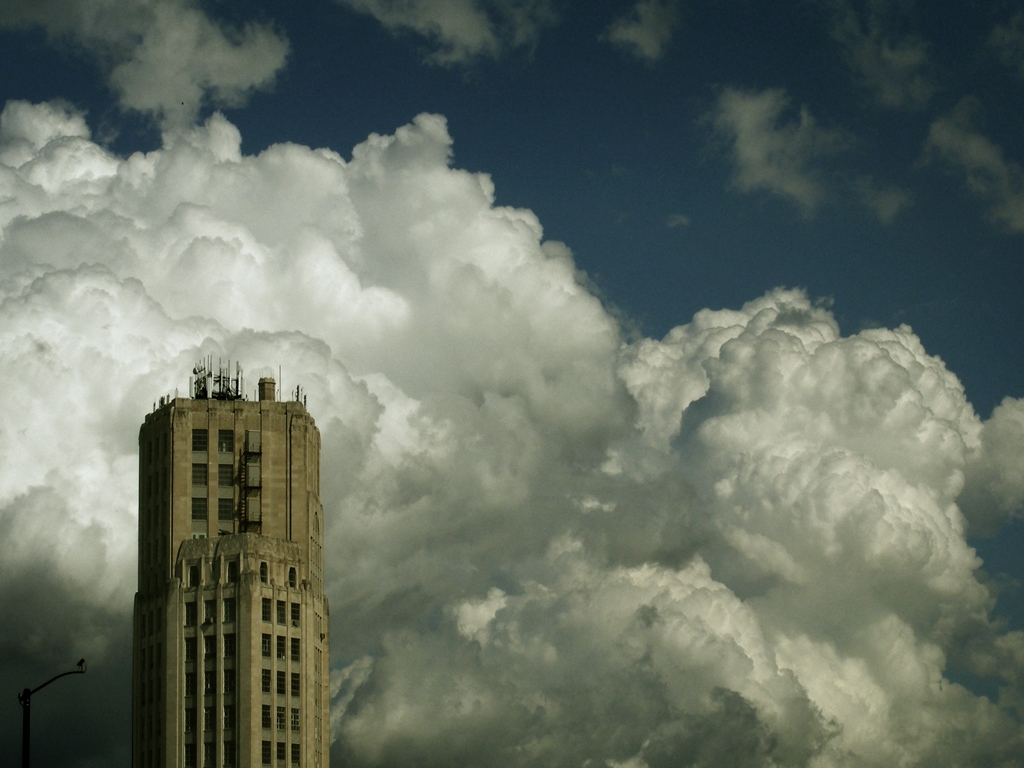 Are you in the cloud? Photo: James Jordan via Flickr.
Are you in the cloud? Photo: James Jordan via Flickr.
 Are you in the cloud? Photo: James Jordan via Flickr.
Are you in the cloud? Photo: James Jordan via Flickr.The privacy debate Consumers are becoming increasingly aware of how they are being tracked by marketers. At the same time advertisers are under more pressure than ever monetize their online investments as they cut offline budgets. Last year was notable in that two major companies have made privacy faux pas: Facebook over profile information and Google over Buzz. These controversies as well as the rise in location-based apps and ever-nichified Facebook ads have made people more aware of exactly how much information marketers have about them. (If you want to know how much personal information marketers know about you, check out rapleaf.com .
How does this apply to arts orgs? At the same time these privacy concerns have surfaced, arts organizations are being persuaded to move to shared service models, in which databases may be shared by multiple organizations, or have started using other platforms which use cloud computing (where the organization’s data is stored on outside servers). As patrons become more aware of where their information is stored, employees also worry about the security of cloud computing. At the same time, they wonder how secure their database was in the first place. Bottom line: arts organizations should remember that it is crucial to be transparent about their privacy policies to patrons.

Arts organizations, most of which position themselves as serving local community, are starting to understand the potential for hyper-local platforms like this. Location-based applications are increasingly attracting young, urban influencers with disposable income—precisely the audience many arts organizations are trying to attract. People connect to geolocation apps primarily to “get informed” and “obtain promotions” rather than “to compete” to become mayor of their favorite locations.
2011 will likely determine which “check-in” application will dominate. As of November 2010 Facebook Places had 7 times more users than FourSquare, but Places users utilize the service less frequently. So, which platform will win out? Independent companies like GoWalla and FourSquare, or platforms emerging from established networks and services like Facebook and Google?
What do you think were the biggest trends in arts marketing in 2010? What do you see ahead for 2011?
10 Arts and Culture Mobile Apps from 2010
Merely half a day away from the end of the year, today is a great day to reflect on all the different happenings in 2010. One of the big things I have been looking back on is the growth of useful mobile apps for arts and culture audiences and managers. Here is a look at ten of these apps from the past year selected by the Technology in the Arts team and you, our lovely readers:
The Florida Grand Opera | FREE
Available for: iPhone, Android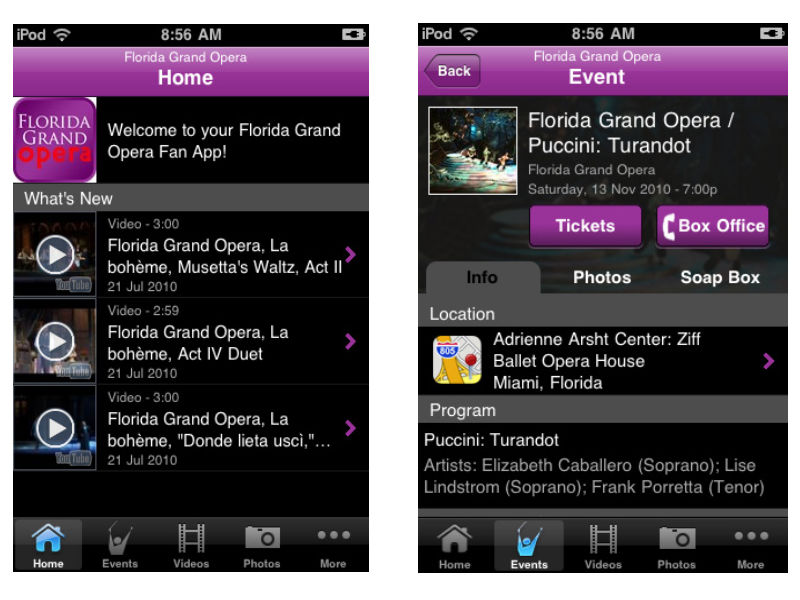 The Breakdown: A great app for the Opera lover in us all, the Florida Grand Opera app offers news about the company, events updates, listings of upcoming performances, and streaming audio of the 2010-2011 season. One aspect of the app I really enjoyed was the videos section, containing a multitude of interviews and performances from the FGO. The only real complaint I have about the app is the necessity to sign up for updates from FGO before being allowed access into the app.
The Breakdown: A great app for the Opera lover in us all, the Florida Grand Opera app offers news about the company, events updates, listings of upcoming performances, and streaming audio of the 2010-2011 season. One aspect of the app I really enjoyed was the videos section, containing a multitude of interviews and performances from the FGO. The only real complaint I have about the app is the necessity to sign up for updates from FGO before being allowed access into the app.
Google Goggles | FREE
Available for: iPhone, Android
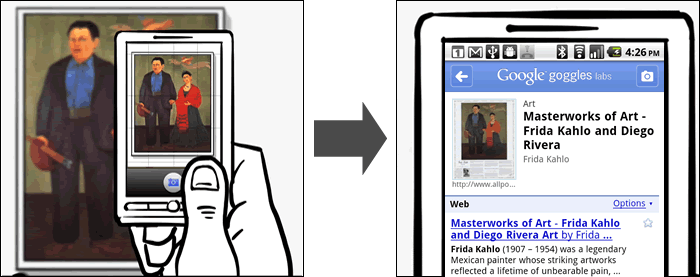
The Breakdown: Google Goggles is a visual search engine built into a mobile app. It utilizes your smartphone's camera to capture and scan an image, object, or landmark and perform a search online to provide information on it. This is a very fun app to play around with and can be very helpful when trying to identify an artwork without a clear label or an unknown landmark. The app is still in beta though and cannot identify anything that is not already currently online in some form.
The L.A. Phil | FREE
Available for: iPhone, Android, & Blackberry
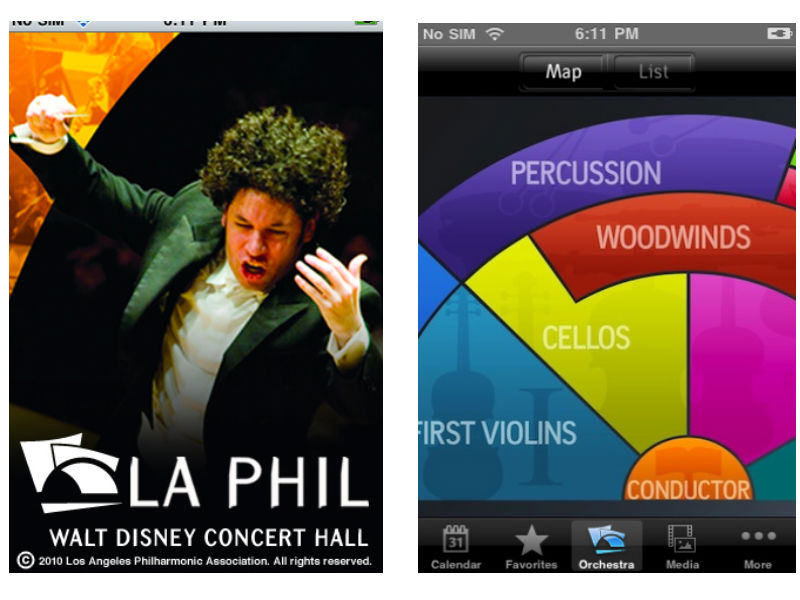 The Breakdown: The LA Philharmonic app has a lot of same offerings as the Florida Grand Opera app in terms of news, media, and listings of events. What sets this app apart is the interactive Orchestra map, laying out the different groups of muscians in the LA Phil. When a user taps on a section of the orchestra, such as First Violins, they are directed to profiles of each musician with in-depth biographies. This app is packed full of great content and an excellent way to learn more about classical music and the people that perform it.
The Breakdown: The LA Philharmonic app has a lot of same offerings as the Florida Grand Opera app in terms of news, media, and listings of events. What sets this app apart is the interactive Orchestra map, laying out the different groups of muscians in the LA Phil. When a user taps on a section of the orchestra, such as First Violins, they are directed to profiles of each musician with in-depth biographies. This app is packed full of great content and an excellent way to learn more about classical music and the people that perform it.
AMNH Explorer | FREE
Available for: iPhone
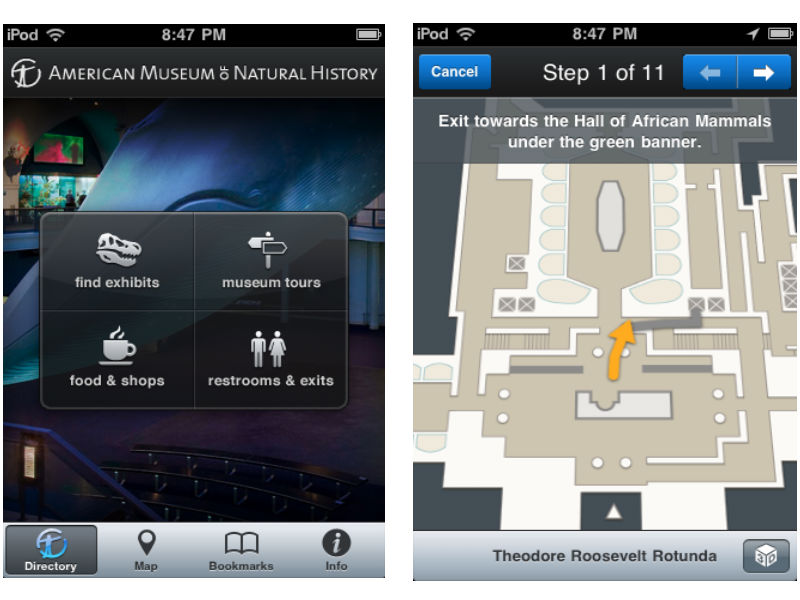 The Breakdown: The Explorer app from the American Museum of Natural History is a great guide for navigating a very large museum. The app acts as a personal in-museum GPS, finding your location and providing information on the exhibits within that area. The app can not only find your location, but provide turn-by-turn directions from one exhibit to the next. This may go against some museum purists love of getting lost within a museum, but on a busy day in a museum packed with visitors this app could be an incredible advantage.
The Breakdown: The Explorer app from the American Museum of Natural History is a great guide for navigating a very large museum. The app acts as a personal in-museum GPS, finding your location and providing information on the exhibits within that area. The app can not only find your location, but provide turn-by-turn directions from one exhibit to the next. This may go against some museum purists love of getting lost within a museum, but on a busy day in a museum packed with visitors this app could be an incredible advantage.
Is This Art? | FREE
Available for: iPhone
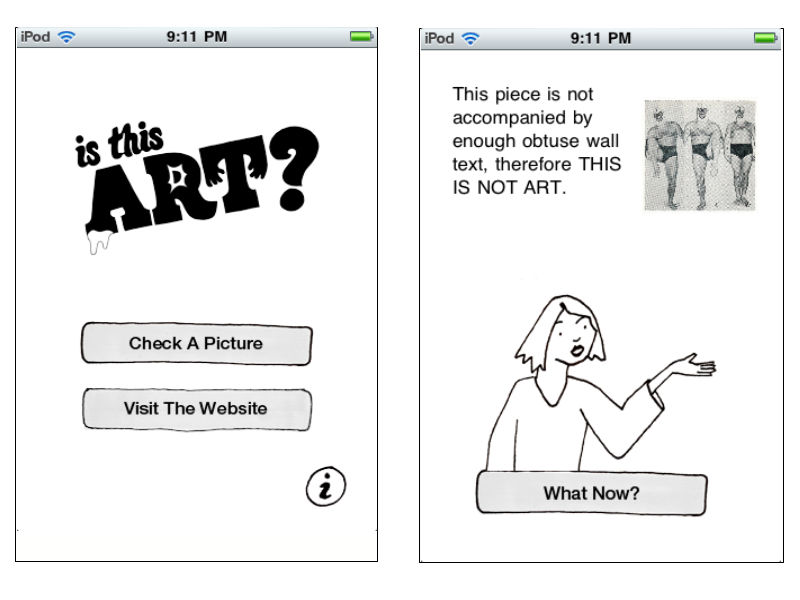 The Breakdown: A fun app from the folks at Deeplocal and the Mattress Factory, Is This Art? is one way to win those age old arguments about what is and isn’t art. Users snap a picture of the art in question and open it within the app to test its validity in the art world. The explanations the app gives are often hilarious such as, "This makes me feel intellectually inferior, therefore THIS IS ART" and, "This piece is not accompanied by enough obtuse wall text, therefore THIS IS NOT ART". All of the images users put to the test can be uploaded to the project's ongoing blog.
The Breakdown: A fun app from the folks at Deeplocal and the Mattress Factory, Is This Art? is one way to win those age old arguments about what is and isn’t art. Users snap a picture of the art in question and open it within the app to test its validity in the art world. The explanations the app gives are often hilarious such as, "This makes me feel intellectually inferior, therefore THIS IS ART" and, "This piece is not accompanied by enough obtuse wall text, therefore THIS IS NOT ART". All of the images users put to the test can be uploaded to the project's ongoing blog.
Brooklyn Museum Mobile | FREE
Available for: iPhone, Android, & Blackberry
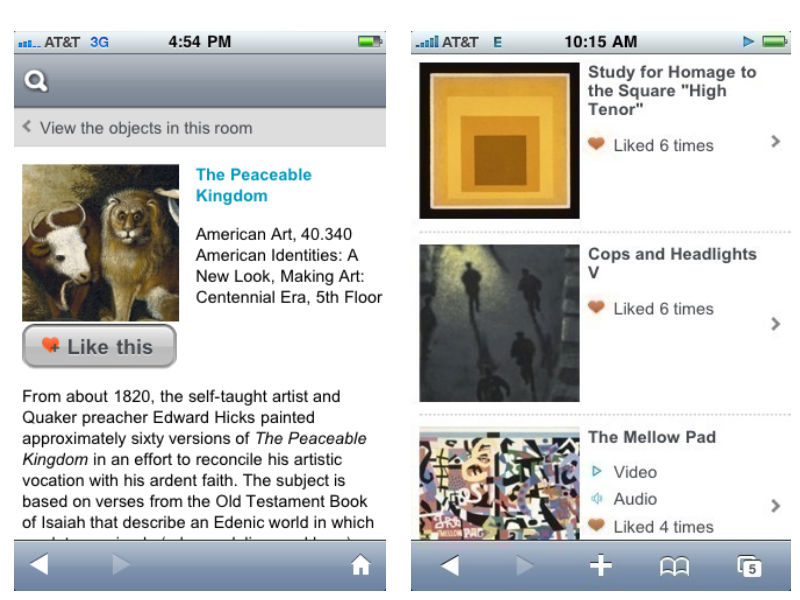
The Breakdown: Another great app for a large museum, Brooklyn Museum Mobile has less of a focus on navigation and more on community and interaction. The app brings in aspects from social media by inviting users to add descriptive tags and/or "like" artworks from the collection. This acts as a recommendation system for other visitors and encourages a more participatory experience. The aspect I like about Brooklyn Museum's offering is that the app runs off of a mobile website, meaning that it is not device exclusive and anyone with a web-enabled device can join in the fun.
The Lighting Handbook | $4.99
Available for: iPhone
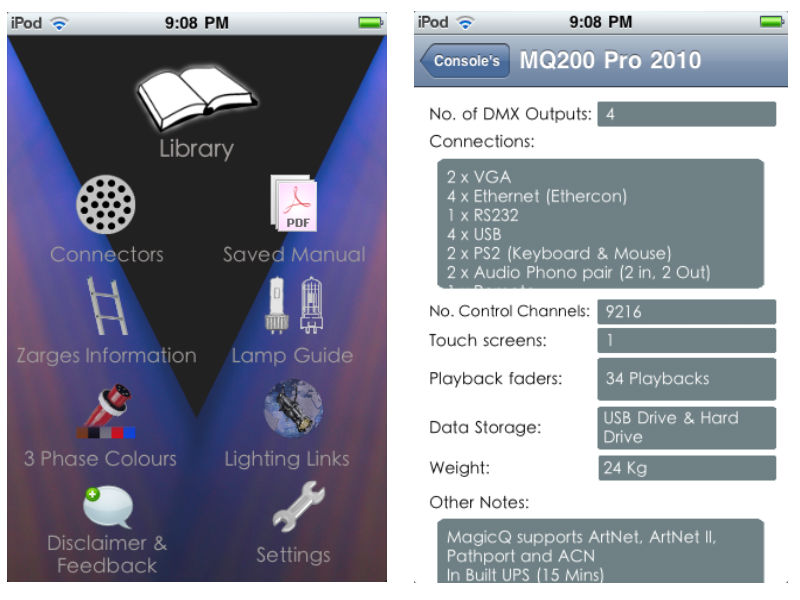 The Breakdown: This is a great app for all of you theater techies. The Lighting Handbook is exactly what it sounds like, an in-depth guide to all things lighting, conveniently in your pocket.
The Breakdown: This is a great app for all of you theater techies. The Lighting Handbook is exactly what it sounds like, an in-depth guide to all things lighting, conveniently in your pocket.
Chicago Gangland Tour | $2.99
Available for: iPhone
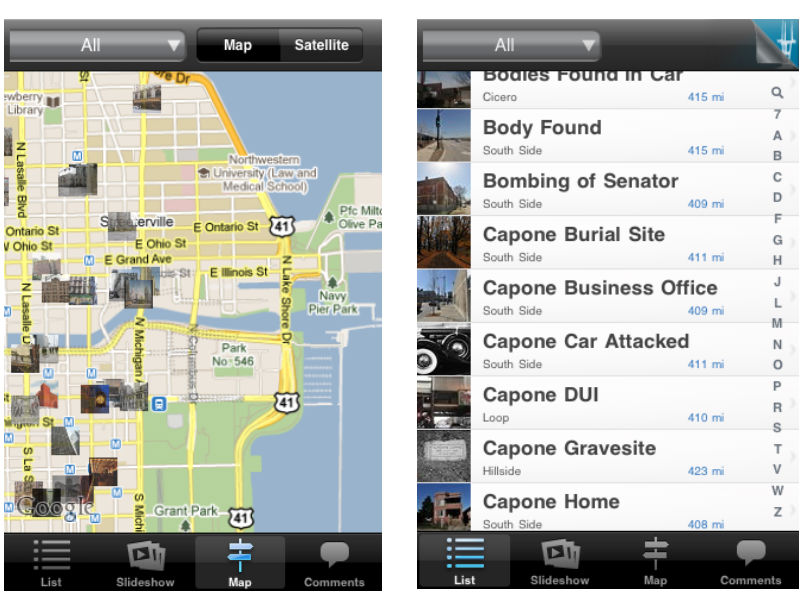
The Breakdown: Ever wanted to walk in the footsteps of famous gangster Al Capone? That's exactly what the Chicago Gangland Tour app helps you do, integrated with google maps to give users a handheld guide for a historical walkthrough of Chicago's mafia history. This app provides info on all the different sites historical relevance and invites users to add their own comments. My favorite aspect of the app is the drop-down menu where results can be sorted by subjects like murders, shootouts, and gangster hideouts.
At The Booth | $0.99
Available for: iPhone, Android
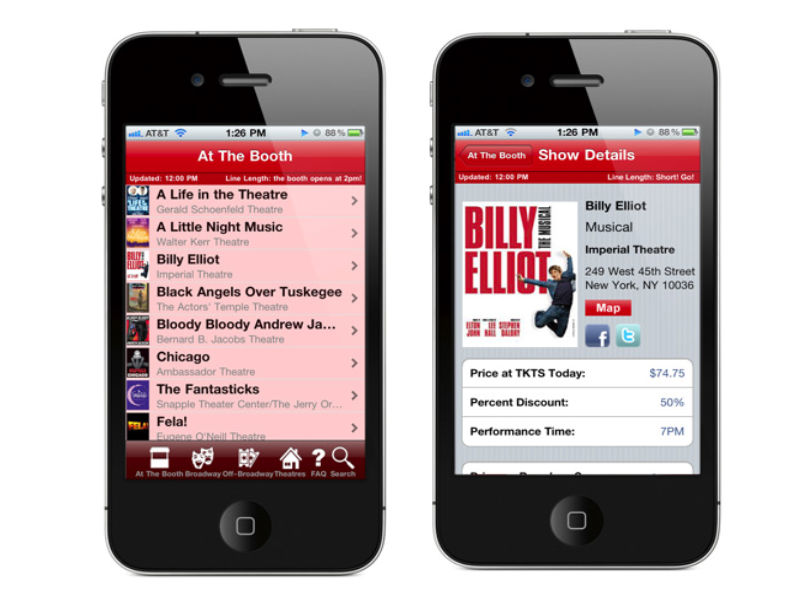 The Breakdown: At The Booth is a full-service app for attendees of Broadway and Off-Broadway shows in New York City. The main page updates with every launch of the app and includes the latest shows and theater locations. For each show the app provides info on the showtimes, ticket prices, discounts, synopses, links to reviews and videos, and nearby restaurants. Listings will appear with a pink undertone to let users know if there are long lines at the theater. The only real complaint I have about the app is that the listings are only viewable in list form, whereas a map option would really assist in seeing all that is available in the immediate area.
The Breakdown: At The Booth is a full-service app for attendees of Broadway and Off-Broadway shows in New York City. The main page updates with every launch of the app and includes the latest shows and theater locations. For each show the app provides info on the showtimes, ticket prices, discounts, synopses, links to reviews and videos, and nearby restaurants. Listings will appear with a pink undertone to let users know if there are long lines at the theater. The only real complaint I have about the app is that the listings are only viewable in list form, whereas a map option would really assist in seeing all that is available in the immediate area.
The Sundance Festival 2010 | $4.99
Available for: iPhone
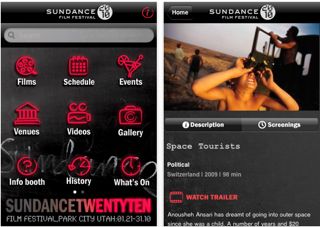
The Breakdown: The Sundance Festival app acts as an online brochure for the annual film festival. In addition to offering videos and reviews on films being shown, the app gives festival attendees real-time updates as to what is happening with the film fest's various events and screenings. The one feature that this app lacks is a way to create custom schedules of screening times and events. This would be invaluable at a festival where multiple things are being offered at once and making the most of the your time requires a lot of planning.
Giving Thanks for Your Fans
Thursday marks that wonderful time of the year when we gather with friends and family, give thanks, and have a perfectly valid excuse to eat too much food and take a nap. So in this time of giving thanks, has your arts organization thought about how you give thanks for your online communities? Offering ways to thank and reward your organization’s online community is an important part of online social engagement. It reinforces for your followers how much you appreciate while giving them great incentives to spread your brand. These rewards can span from offering exclusive content only available to your online fan base to having something tangible like a specific event or rewards day at your organization focused on your online community.
Take for example the recent move by Barry and Fran Weissler, producers of the musical Chicago, to reward their Facebook fans. On January 30, 2011, Facebook Fan Day will mark the first time that a Broadway show will fill its house exclusively with their Facebook fans -- for free. Yes, the tickets were free, but they were not simply first come, first served. Tickets were distributed chronologically to those people who got ten of their friends to “Like” the Chicago Facebook page.
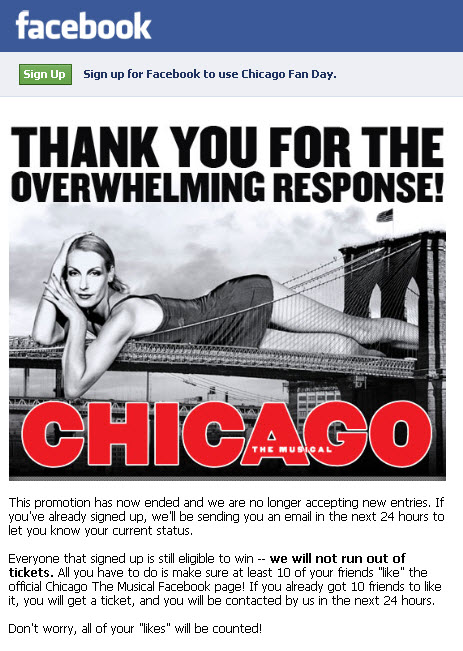
-
Facebook Fan Day generated quite a bit of buzz and interest in a production that has been running for 15 years.

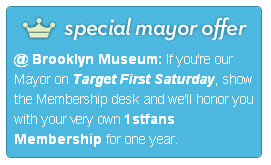
- Brooklyn Museum's special offer on Foursquare

While an idea like Facebook Fan Day is a great way to reward and expand your organization’s online presence, it doesn’t necessarily need to be a one-time offering. The folks over at Brooklyn Museum have included an on-going rewards program for their Foursquare community. By becoming Brooklyn Museum’s "mayor" on Foursquare during their First Saturday social event, a visitor can receive a free one year membership for their 1stfans social event program. One advantage to using a location based platform is that it requires users to be present at the event in order to and claim the reward. Rewarding your social media fans can increase their loyalty to your organization, give them some incentives to get through the door and create more advocates to spread your brand. What does (or could) your organization do to give thanks to members of your online communities?






